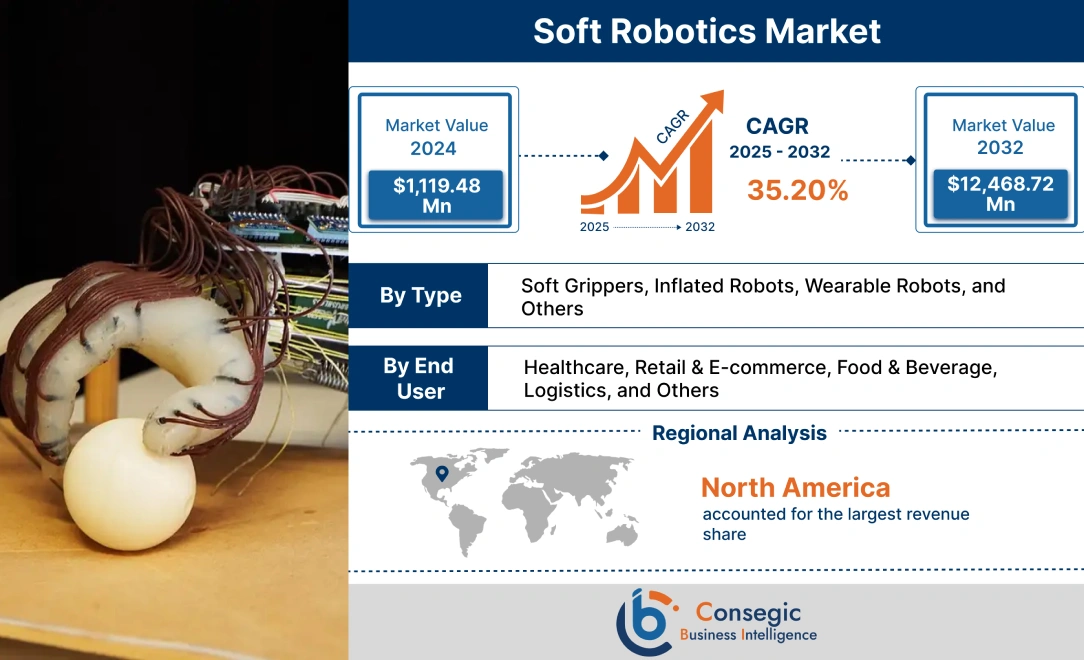- Summary
- Table Of Content
- Methodology
Soft Robotics Market Scope & Overview:
Soft robotics refers to the subset of robotics that primarily emphasizes technologies that closely resemble the physical features of living organisms. This involves the design, control, and fabrication of robots that are composed of compliant materials rather than rigid links.
Moreover, they offer a range of benefits including adaptable shape, high elasticity, multi-functionality, collision avoidance through impact absorption, and the ability to attain complex motion. The aforementioned benefits are key determinants for increasing its deployment in healthcare, retail & e-commerce, food & beverage, logistics, and other industries.
Soft Robotics Market Size :
The Soft Robotics Market is projected to reach over USD 12,468.72 million by 2032, growing from USD 1,493.14 million in 2025, at a CAGR of 35.20% from 2025 to 2032.
Soft Robotics Market Insights:
Soft Robotics Market Dynamics - (DRO) :
Key Drivers :
Growing healthcare sector is spurring the market
Soft robotics is primarily deployed in the healthcare sector for various applications including rehabilitation, diagnostic, and surgical procedures among others. They are composed of materials that are similar in softness to human soft tissues and are compatible with human interaction. Moreover, they are capable of matching with biological structures and have applications in artificial muscles, prosthetic devices, muscle alternatives, stents, catheters, and surgical instruments among others.
Factors including the increasing trend in healthcare expenditure, rising incidence of diagnostics and surgical procedures, and growing investments in advanced medical equipment are primary aspects driving the healthcare sector.
For instance, according to the American Medical Association, the total healthcare spending in the United States reached up to USD 4.3 trillion in 2021, witnessing a rise in comparison to 2020. Healthcare expenditure in the United States accounted for 18.3% of the total GDP in 2021.
Additionally, the European Commission invested around USD 6 billion budget during the 2021-27 period to support the healthcare sector in Europe. Thus, the analysis of market trends shows that the growing healthcare sector is driving the adoption for application in rehabilitation, diagnostic, and surgical procedures among others, in turn, driving the soft robotics market growth.
Rising utilization in the food & beverage sector is driving the market
Soft robotics are used in the food & beverage sector, particularly for facilitating automation in food processing and manufacturing processes. Soft robotic grippers are deployed in food processing facilities for applications ranging from handling, and picking to packaging of food & beverage products.
Moreover, they offer various benefits including greater adaptability, reduced product damage, efficient handling of bulk products, reduced automation footprint, and elimination of human touch among others. The aforementioned benefits are prime determinants for increasing its utilization in the food & beverage sector.
Factors including significant investments in the food & beverage sector, increasing consumer demand for packaged and processed food products, rising hygiene standards in the food sector, and growing demand for food processing automation solutions are major prospects driving the adoption.
For instance, according to Food Drink Europe, a European Union confederation for the food sector, the European Union food and beverage sector was valued at EUR 1,121 billion (USD 1,292.0 billion) in 2022, representing an increase of 2.6% in comparison to EUR 1,093 billion (USD 1,177.8 billion) in 2021.
Therefore, analysis of market trends shows that the growing food & beverage sector is increasing the adoption for applications ranging from handling, and picking to packaging of food & beverage products, in turn proliferating the soft robotics market growth.
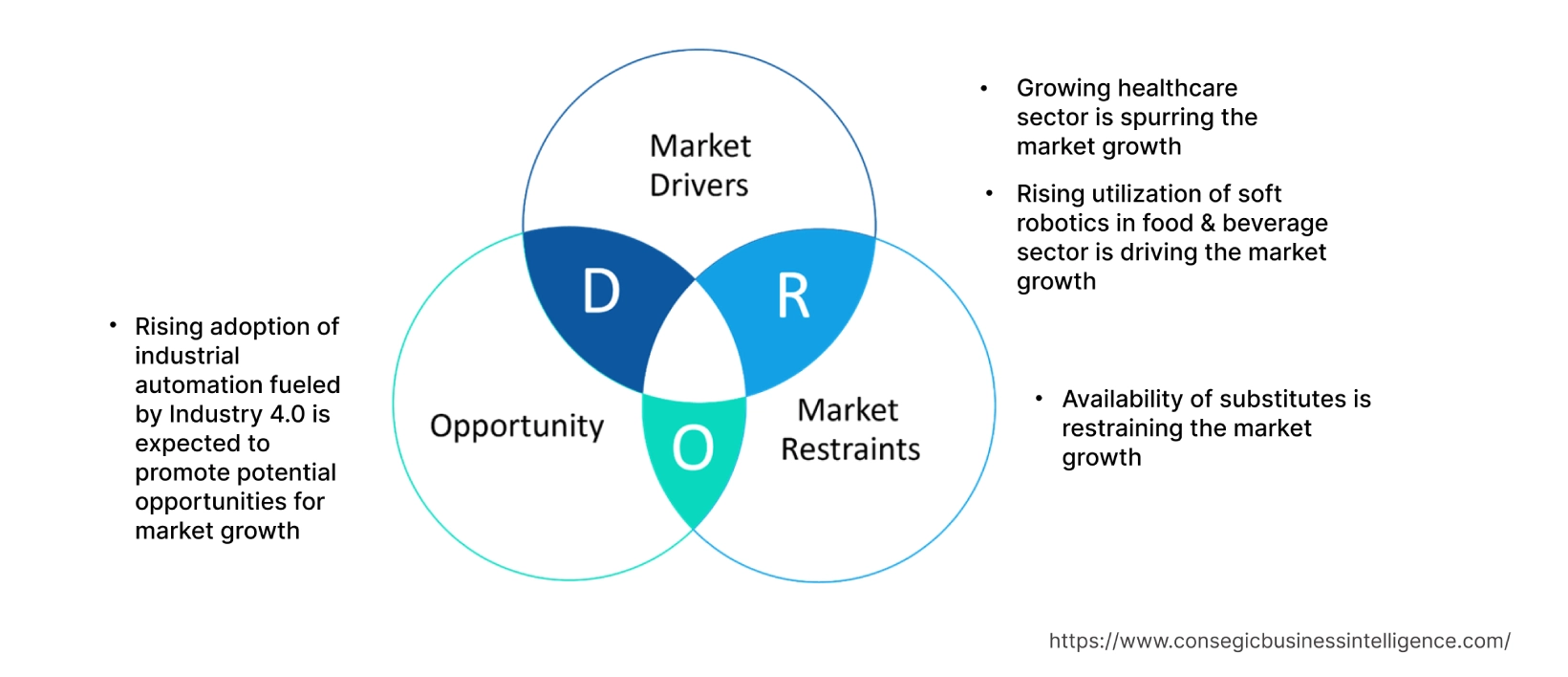
Key Restraints :
Availability of substitutes is restraining the market
Soft robotics have multiple substitutes such as hard robotics, and others. Comparatively, the substitutes have similar properties, performance, and applications, concerning robotics, which is a significant factor limiting the soft robotics market opportunities.
For instance, hard robots act as an ideal alternative to soft robots for application in logistics, retail & e-commerce, automotive, and other industrial sectors for automating material handling, transport, and industrial processes. Moreover, hard robots are equally capable of driving industrial automation and enhancing production efficiency as compared to soft robots.
Additionally, the utilization of hard robotics offers a range of benefits including high strength and durability, high precision and repeatability in movement, relatively simple control and power requirements, and excellent load capacity for heavy-duty applications. Therefore, the analysis of market trends shows that the availability of substitutes is constraining the soft robotics market demand.
Future Opportunities :
Rising adoption of industrial automation fueled by Industry 4.0 is expected to promote potential opportunities for the market
Industry 4.0-enabled manufacturing depicts extreme flexibility, automation readiness, minimal human intervention, and the highest productivity. In addition, soft robots are used for the assembly of several parts during industrial manufacturing. Moreover, the utilization also automates the process of picking and transporting individual items along with automating the handling and moving of parts & materials in industrial facilities.
The deployment of industrial automation offers multiple benefits including high accuracy & precision, faster processes, improved worker safety, and enhanced operational efficiency.Factors including the rising pace of industrialization, increasing investments in the expansion of industrial manufacturing facilities, and the rising trend of industrial automation fueled by Industry 4.0 are expected to promote lucrative development aspects for the market.
For instance, the government of Germany launched the "Industry 4.0" initiative to promote the development of digital technologies in manufacturing. The initiative also aims at supporting automation in manufacturing along with enhancing Germany's competitiveness in the manufacturing sector.
Therefore, the rising government initiatives towards industrial automation are anticipated to increase the application to automate industrial processes and enhance operational efficiency, in turn promoting soft robotics market opportunities during the forecast period.
Top Key Players & Market Share Insights:
The soft robotics market is highly competitive with major players providing soft robotics to the national and international markets. Key players are adopting several strategies in research and development (R&D), product innovation, and application launches to hold a strong position in the soft robotics market. Key players in the soft robotics industry include-
- Soft Robotics Inc.
- Ekso Bionics Holdings Inc.
- Roam Robotics
- ABB Ltd.
- KUKA AG
- Rewalk Robotics Ltd.
- RightHand Robotics Inc.
- Yaskawa Electric Corporation
- Bioservo Technologies AB
- Festo Inc.
Soft Robotics Market Segmental Analysis :
By Type :
Based on the type, the market is segmented into soft grippers, inflated robots, wearable robots, and others. The wearable robots segment accounted for the largest revenue share of 45.4% in the year 2024 of the global soft robotics market share. They refer to a particular type of wearable device that is designed to enhance a person's motion or physical abilities. Moreover, they are optimized for assisting impaired limbs, boosting human ability, or helping with the rehabilitation of neuromuscular impairments. Additionally, they offer several benefits including lightweight, ease of wear and removal, increased functionality and mobility, and continuous adaptability to evolving consumer needs. The aforementioned benefits are key aspects for driving its adoption in healthcare and other industrial sectors.
In September 2019, Hyundai launched its new wearable robot, the vest exoskeleton which is particularly designed for assisting industrial workers spending long hours working in overhead environments. The wearable robot helps enhance productivity and reduce fatigue of industrial workers by imitating the movement of human joints to augment mobility and load support. Therefore, the rising advancements associated with wearable robots are among the key factors driving the soft robotics market demand.
The soft grippers segment is anticipated to register the fastest CAGR during the forecast period. They are designed for handling delicate objects without causing damage. Moreover, they have considerable flexibility that enables them to grasp a variety of objects. The high flexibility and dexterity are primary determinants for increasing their application in food & beverage, logistics, and retail & e-commerce sectors among others.
For instance, according to the U.S. Census Bureau of the Department of Commerce, the retail e-commerce sector in the United States was valued at USD 265.95 billion during the third quarter of 2022, representing a significant rise of 10.8% in comparison to USD 239.97 billion during the third quarter of 2021. Soft grippers are often used in retail warehouses to automate the processes involved in the picking, handling, and packaging of retail goods and products. Hence, market analysis shows that the growing retail & e-commerce sector is anticipated to drive the soft robotics market trends during the forecast period.
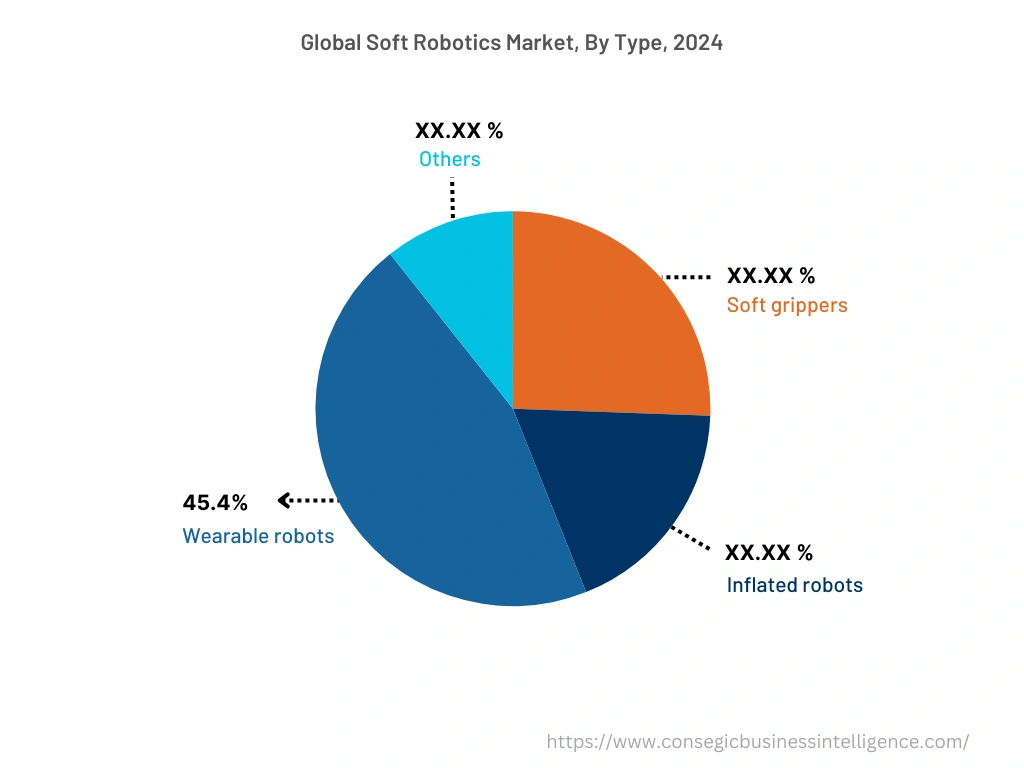
By End-User :
Based on the end-user, the market is segregated into healthcare, retail & e-commerce, food & beverage, logistics, and others. The healthcare segment accounted for the largest revenue share in the year 2024 of the total soft robotics market share. Factors including the growing trend in healthcare expenditure, increasing incidence of chronic diseases, rising incidence of surgical procedures, and advancements in medical equipment are crucial prospects driving the healthcare segment.
For instance, according to the European Commission, the total government healthcare expenditure in the EU reached up to USD 202.7 billion in 2021, accounting for 8.1% of the total GDP. Hence, the analysis shows that the rising healthcare sector is driving the adoption for utilization in rehabilitation, diagnostic, and surgical procedures among others, in turn proliferating the market.
The food & beverage segment is expected to witness the fastest CAGR during the forecast period. The growing food & beverage segment is attributed to several factors including increasing consumer demand for packaged and processed food products, growing investments in expansion of food & beverage manufacturing facilities, and rising demand for automation in food processing solutions.
For instance, in March 2022, Kerry Group, a food and beverage company, launched its new food manufacturing facility worth USD 137 million in Georgia, United States. Therefore, the analysis of segment trends shows that the rising development of food processing facilities is projected to drive the adoption for applications ranging from handling, and picking to packaging of food products, in turn driving the soft robotics market trends during the forecast period.
Soft Robotics Market Report Insights :
| Report Attributes | Report Details |
| Study Timeline | 2019-2032 |
| Market Size in 2032 | USD 12,468.72 Million |
| CAGR (2025-2032) | 35.20% |
| By Type | Soft Grippers, Inflated Robots, Wearable Robots, and Others |
| By End-User | Healthcare, Retail & E-commerce, Food & Beverage, Logistics, and Others |
| By Region | North America, Europe, Asia-Pacific, Latin America, and Middle East & Africa |
| Key Players | Soft Robotics Inc., Ekso Bionics Holdings Inc., Rewalk Robotics Ltd., RightHand Robotics Inc., Yaskawa Electric Corporation, Bioservo Technologies AB, Festo Inc., Roam Robotics, ABB Ltd., KUKA AG |
By Region :
The regional segment includes North America, Europe, Asia Pacific, Middle East and Africa, and Latin America.
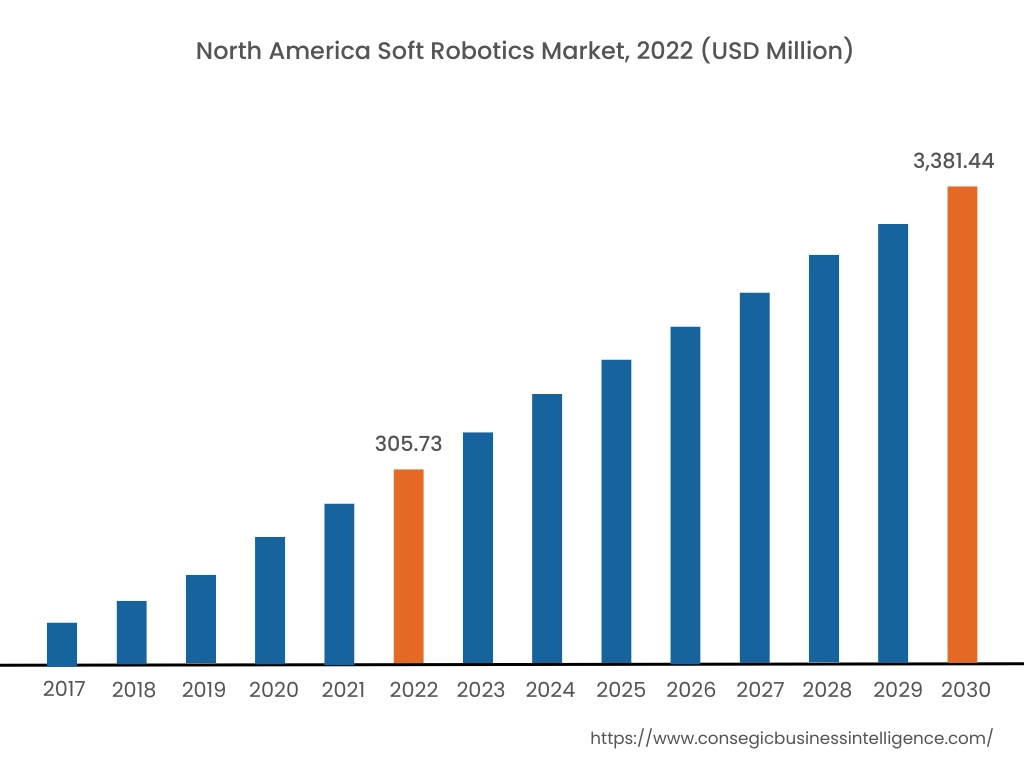
North America accounted for the largest revenue share of USD 371.34 Million in 2024 and is expected to reach USD 4,041.11 Million by 2032, registering a CAGR of 34.8% during the forecast period. In addition, in the region, the U.S. accounted for the maximum revenue share of 65.7% in the same year. As per the soft robotics market analysis, the adoption of robotics in the North American region is primarily driven by its usage in food & beverage, logistics, healthcare, and other sectors. Additionally, the market analysis depicts that the increasing application of robotics in food & beverage plants for picking, moving, assembling, and packing finished products is among the significant factors driving the market in the region.
For instance, in August 2021, Tyson Foods, invested USD 300 million to build a food processing facility in Virginia, U.S. The facility is scheduled to be operational in 2023. Thus, the analysis shows that the above factors are further propelling the soft robotics market in the North American region. Further, the increasing investment in retail & e-commerce and logistics sectors is a vital factor expected to drive the market growth in North America during the forecast period.
Asia-Pacific is expected to register the fastest CAGR of 35.70% during the forecast period. The growing pace of industrialization and development is creating lucrative growth prospects for the market in the region. Additionally, factors including the growth of multiple industries such as retail & e-commerce, healthcare, and others are fostering the soft robotics market in the Asia-Pacific region.
For instance, in April 2022, the Indian Government announced the launch of an online retail network across 100 cities in India, to provide consumers with an alternative to multinational platforms including Amazon and Flipkart. Hence, the growing retail & e-commerce sector is anticipated to drive the utilization of robotics in retail warehouses for automating the processes involved in picking, handling, and packaging of retail goods and products, thereby, fueling the market growth in the Asia-Pacific region during the forecast period.
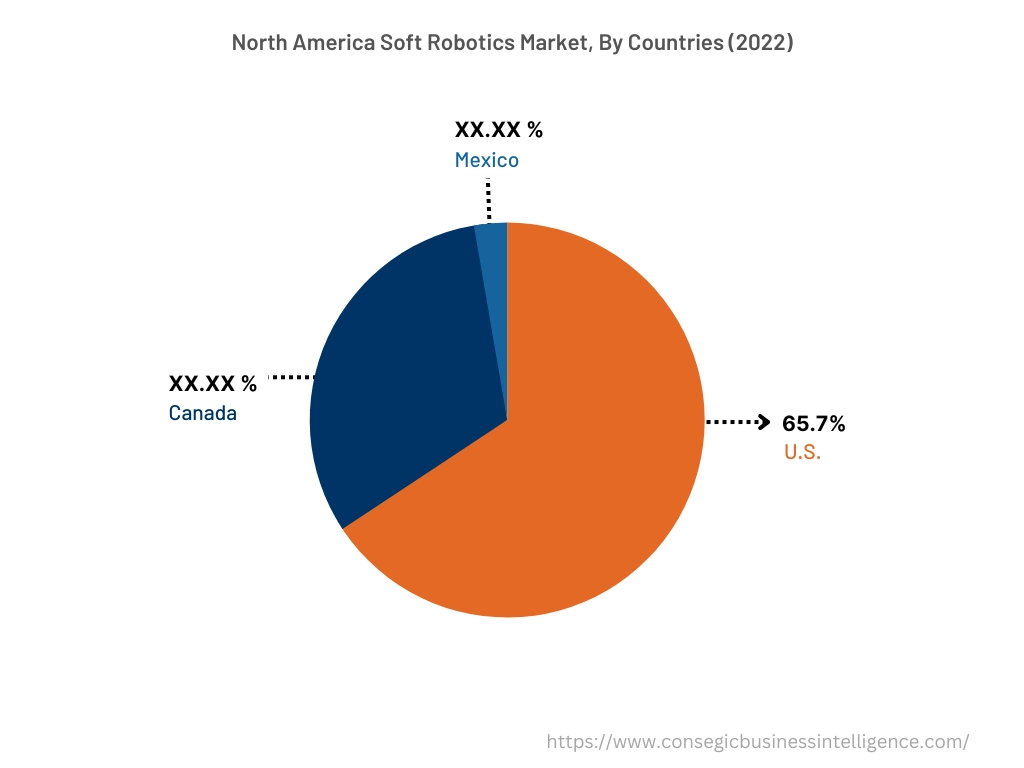
Recent Industry Developments :
- In August 2023, ReWalk Robotics Ltd. announced the acquisition of AlterG Inc., a manufacturer of anti-gravity systems for utilization in physical and neurological rehabilitation. The acquisition aims to expand ReWalk's existing portfolio of neuro-rehabilitation products and facilitate future growth.
Key Questions Answered in the Report
What is soft robotics? +
Soft robotics refers to the subset of robotics that primarily emphases on technologies that closely resemble the physical features of living organisms. Soft robotics involves the design, control, and fabrication of robots that are composed of compliant materials rather than rigid links.
What specific segmentation details are covered in the soft robotics report, and how is the dominating segment impacting the market growth? +
For instance, by type segment has witnessed wearable robots as the dominating segment in the year 2024, owing to its increasing utilization in healthcare and other industrial sectors.
What specific segmentation details are covered in the soft robotics market report, and how is the fastest segment anticipated to impact the market growth? +
For instance, by end-user segment has witnessed food & beverage as the fastest-growing segment during the forecast period due to the rising adoption of soft robotics for applications ranging from handling, picking to packaging of food products.
Which region/country is anticipated to witness the highest CAGR during the forecast period, 2025-2032? +
Asia-Pacific is anticipated to register fastest CAGR growth of 35.5% during the forecast period due to rapid pace of industrialization and growth of multiple industries such as retail & e-commerce, healthcare, and others.
